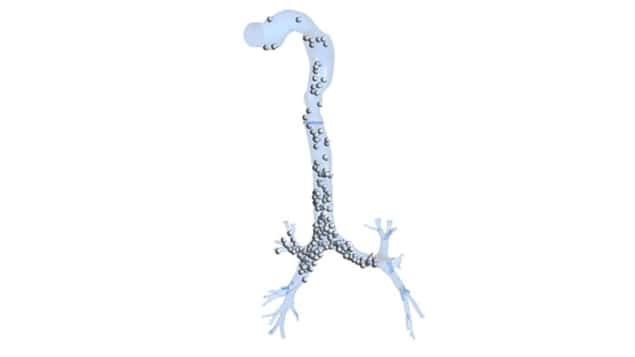Fluid dynamics study could make medical inhalers more effective
05 Sep 2021
Researchers in India and Australia have simulated the delivery of drugs used to treat pulmonary illnesses. Using a replica of the respiratory system, combined with fluid dynamics simulations, a team led by Suvash Saha at the University of Technology Sydney showed how smaller drug particles tend to reach smaller bronchi in the lungs more easily. The discovery could provide valuable guidance for clinicians in improving designs of both drugs and inhalers.
With levels of air pollution increasing in many cities – particularly in lower-income countries, lung diseases are a growing concern worldwide. Currently, among the most widely used methods to manage these diseases is through dry powder inhalers (DPIs): which disperse microscopic drug particles throughout a user’s lungs as they inhale through the device.
DPIs are particularly useful because they do not require a propellant, deliver more consistent doses, and enable a more widespread deposition of drugs within the bronchi of the lungs than other treatment devices. Yet despite these advantages, fewer than 30% of the drug particles delivered by DPIs actually settle within the lungs. Such a low efficiency is driving up the costs of drug doses, making treatments less accessible to the many millions of people who could benefit from inhalers.
Computational fluid dynamics
In previous studies, researchers have shown how this efficiency can be affected by the sizes of drug particles within the doses delivered by DPIs. To investigate this effect, Saha’s team developed a replica of the human respiratory tract, based on 3D images taken by computer tomography. By combining their model with computational fluid dynamics, they then simulated the deposition of different-sized drug particles onto different parts of the respiratory tract.
To recreate variations in human breathing, the researchers measured how depositions of the particles varied with different inhalation rates. They discovered that larger particles, as well as those those inhaled at faster speeds, were more likely to be deposited in the mouth. Since these particles carry higher inertial forces, they could less readily change direction at the sharp turn from the mouth into the trachea – causing more of them to settle before reaching the lungs.READ MORE

In contrast, finer particles could more easily disperse into the bronchi: the passages in the lungs which branch out into ever finer structures, where gas exchange occurs. In addition, the simulations revealed that more particles were deposited in the bronchi of the right lung than the left – whose shape is distorted to accommodate the heart.
Based on their results, Saha and colleagues now propose that existing treatments for pulmonary diseases could improve through the use of smaller drug particles, which could more readily access the bronchi where breathing problems arise. They hope that their discoveries will help clinicians to design more effective drugs, and better devices for administering them.
The research is described in Physics of Fluids.
Sam Jarman is a science writer based in the UK
from physicsworld.com 5/9/2021

Δεν υπάρχουν σχόλια:
Δημοσίευση σχολίου